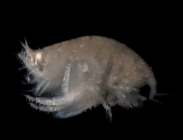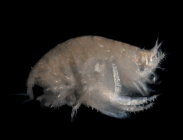WoRMS taxon details
Urothoe poseidonis Reibish, 1905
103235 (urn:lsid:marinespecies.org:taxname:103235)
accepted
Species
Urothoe grimaldii inermis Stebbing, 1906 · unaccepted (Synonym)
Urothoe inermis Chevreux & Fage, 1925 · unaccepted (Synonym)
marine, brackish, fresh, terrestrial
Reibisch, J. (1905). Faunistisch-biologische Untersuchungen über Amphipoden der Noordsee. <em>Wiss. Meeresuntersuch. Abth. Kiel.</em> 8: 147-188, pls. iv & v. (look up in IMIS)
page(s): 163 (18 pdf) [details]
page(s): 163 (18 pdf) [details]
Description An amphipod with a relatively rounded, broad and robust body (like Urothoe brevicornis). The eyes are very large in males...
Distribution In both periods Urothoe poseidonis mainly occurred in the near-coastal zone, with the exception of the eastern coastal zone...
Distribution In the studied area U. poseidonis is much more common than U. brevicornis. The species is very abundant in the Southern...
Description An amphipod with a relatively rounded, broad and robust body (like Urothoe brevicornis). The eyes are very large in males and contiguous on top of the head. The eyes of females are smaller and oval. The body is reddish in colour. Differs from U. brevicornis in having a much broader fifth pair of legs. [details]
Distribution In both periods Urothoe poseidonis mainly occurred in the near-coastal zone, with the exception of the eastern coastal zone...
Distribution In both periods Urothoe poseidonis mainly occurred in the near-coastal zone, with the exception of the eastern coastal zone but with the inclusion of the western Flemish Banks. Whereas the species was only found 15 times and with a maximum density of 50 ind./m2 in the 1976-1986 period, the species had a higher distribution frequency and maximum density (750 ind./m2) in the 1994-2001 period. In the latter period the species was mainly found in the western near-coastal zone. [details]
Distribution In the studied area U. poseidonis is much more common than U. brevicornis. The species is very abundant in the Southern...
Distribution In the studied area U. poseidonis is much more common than U. brevicornis. The species is very abundant in the Southern Bight, with highest densities near the coast. U. poseidonis also lives offshore at the shallow Dogger Bank, but is absent from the Oyster Ground. The species is present in the Oosterschelde and several parts of the Wadden Sea. Previously, it has also been found in the Westerschelde (Heip et al., 1986). [details]
Horton, T.; Lowry, J.; De Broyer, C.; Bellan-Santini, D.; Copila?-Ciocianu, D.; Corbari, L.; Costello, M.J.; Daneliya, M.; Dauvin, J.-C.; Fišer, C.; Gasca, R.; Grabowski, M.; Guerra-García, J.M.; Hendrycks, E.; Hughes, L.; Jaume, D.; Jazdzewski, K.; Kim, Y.-H.; King, R.; Krapp-Schickel, T.; LeCroy, S.; Lörz, A.-N.; Mamos, T.; Senna, A.R.; Serejo, C.; Souza-Filho, J.F.; Tandberg, A.H.; Thomas, J.D.; Thurston, M.; Vader, W.; Väinölä, R.; Valls Domedel, G.; Vonk, R.; White, K.; Zeidler, W. (2024). World Amphipoda Database. Urothoe poseidonis Reibish, 1905. Accessed through: World Register of Marine Species at: https://www.marinespecies.org/aphia.php?p=taxdetails&id=103235 on 2024-04-24
Date
action
by
![]() The webpage text is licensed under a Creative Commons Attribution 4.0 License
The webpage text is licensed under a Creative Commons Attribution 4.0 License
original description
Reibisch, J. (1905). Faunistisch-biologische Untersuchungen über Amphipoden der Noordsee. <em>Wiss. Meeresuntersuch. Abth. Kiel.</em> 8: 147-188, pls. iv & v. (look up in IMIS)
page(s): 163 (18 pdf) [details]
original description (of Urothoe inermis Chevreux & Fage, 1925) Chevreux, E. & Fage, L. (1925). Amphipodes. <em>Faune de France.</em> 9, 488 pp.; 438 figs., available online at http://faunedefrance.org/bibliotheque/docs/CHEVREUX&FAGE(FdeFr09)Amphipodes.pdf
page(s): 100; note: as Urothoe var. inermis [details] Available for editors [request]
[request]
context source (Schelde) Maris, T.; Beauchard, O.; Van Damme, S.; Van den Bergh, E.; Wijnhoven, S.; Meire, P. (2013). Referentiematrices en Ecotoopoppervlaktes Annex bij de Evaluatiemethodiek Schelde-estuarium Studie naar “Ecotoopoppervlaktes en intactness index”. <em>Monitor Taskforce Publication Series, 2013-01. NIOZ: Yerseke.</em> 35 pp. (look up in IMIS) [details]
context source (BeRMS 2020) Bio-environmental research group; Institute of Agricultural and Fisheries research (ILVO), Belgium; (2015): Macrobenthos monitoring in function of the Water Framework Directive in the period 2007-2009. [details]
basis of record Bellan-Santini, D.; Costello, M.J. (2001). Amphipoda. <em>in: Costello, M.J. et al. (Ed.) (2001). European register of marine species: a check-list of the marine species in Europe and a bibliography of guides to their identification.</em> Collection Patrimoines Naturels 50: pp. 295-308. (look up in IMIS) [details]
additional source Bachelet, G.; Dauvin, J.-C.; Sorbe, J. C. (2003). An updated checklist of marine and brackish water Amphipoda (Crustacea: Peracarida) of the southern Bay of Biscay (NE Atlantic). <em>Cah. Biol. Mar.</em> 44(2): 121-151. (look up in IMIS) [details] Available for editors [request]
[request]
additional source Muller, Y. (2004). Faune et flore du littoral du Nord, du Pas-de-Calais et de la Belgique: inventaire. [Coastal fauna and flora of the Nord, Pas-de-Calais and Belgium: inventory]. <em>Commission Régionale de Biologie Région Nord Pas-de-Calais: France.</em> 307 pp., available online at http://www.vliz.be/imisdocs/publications/145561.pdf [details]
additional source Lincoln, R. J. (1979). British marine Amphipoda: Gammaridea. <em>British Museum (Natural History).</em> 658 pp. (look up in IMIS) [details] Available for editors [request]
[request]
page(s): 163 (18 pdf) [details]
original description (of Urothoe inermis Chevreux & Fage, 1925) Chevreux, E. & Fage, L. (1925). Amphipodes. <em>Faune de France.</em> 9, 488 pp.; 438 figs., available online at http://faunedefrance.org/bibliotheque/docs/CHEVREUX&FAGE(FdeFr09)Amphipodes.pdf
page(s): 100; note: as Urothoe var. inermis [details] Available for editors
context source (Schelde) Maris, T.; Beauchard, O.; Van Damme, S.; Van den Bergh, E.; Wijnhoven, S.; Meire, P. (2013). Referentiematrices en Ecotoopoppervlaktes Annex bij de Evaluatiemethodiek Schelde-estuarium Studie naar “Ecotoopoppervlaktes en intactness index”. <em>Monitor Taskforce Publication Series, 2013-01. NIOZ: Yerseke.</em> 35 pp. (look up in IMIS) [details]
context source (BeRMS 2020) Bio-environmental research group; Institute of Agricultural and Fisheries research (ILVO), Belgium; (2015): Macrobenthos monitoring in function of the Water Framework Directive in the period 2007-2009. [details]
basis of record Bellan-Santini, D.; Costello, M.J. (2001). Amphipoda. <em>in: Costello, M.J. et al. (Ed.) (2001). European register of marine species: a check-list of the marine species in Europe and a bibliography of guides to their identification.</em> Collection Patrimoines Naturels 50: pp. 295-308. (look up in IMIS) [details]
additional source Bachelet, G.; Dauvin, J.-C.; Sorbe, J. C. (2003). An updated checklist of marine and brackish water Amphipoda (Crustacea: Peracarida) of the southern Bay of Biscay (NE Atlantic). <em>Cah. Biol. Mar.</em> 44(2): 121-151. (look up in IMIS) [details] Available for editors
additional source Muller, Y. (2004). Faune et flore du littoral du Nord, du Pas-de-Calais et de la Belgique: inventaire. [Coastal fauna and flora of the Nord, Pas-de-Calais and Belgium: inventory]. <em>Commission Régionale de Biologie Région Nord Pas-de-Calais: France.</em> 307 pp., available online at http://www.vliz.be/imisdocs/publications/145561.pdf [details]
additional source Lincoln, R. J. (1979). British marine Amphipoda: Gammaridea. <em>British Museum (Natural History).</em> 658 pp. (look up in IMIS) [details] Available for editors
 Present
Present  Present in aphia/obis/gbif/idigbio
Present in aphia/obis/gbif/idigbio  Inaccurate
Inaccurate  Introduced: alien
Introduced: alien  Containing type locality
Containing type locality
From other sources
Biology U. poseidonis shows two types of movement, swimming and burrowing into the sediment (Watkin, 1939a). Little is known of its life cycle. Generally, breeding behaviour of infaunal amphipods is influenced by location. In deeper waters the spring rise in temperature initiates breeding, while in shallower waters it is induced by tidal phasing (Wolff, 1973; Fish & Fish, 1989). The species of the genus Urothoe may be considered selective deposit feeders. They feed by cleaning sand grains from adhering micro-organisms and detritus (Nicolaisen & Kanneworff, 1969). [details]Description An amphipod with a relatively rounded, broad and robust body (like Urothoe brevicornis). The eyes are very large in males and contiguous on top of the head. The eyes of females are smaller and oval. The body is reddish in colour. Differs from U. brevicornis in having a much broader fifth pair of legs. [details]
Distribution In both periods Urothoe poseidonis mainly occurred in the near-coastal zone, with the exception of the eastern coastal zone but with the inclusion of the western Flemish Banks. Whereas the species was only found 15 times and with a maximum density of 50 ind./m2 in the 1976-1986 period, the species had a higher distribution frequency and maximum density (750 ind./m2) in the 1994-2001 period. In the latter period the species was mainly found in the western near-coastal zone. [details]
Distribution In the studied area U. poseidonis is much more common than U. brevicornis. The species is very abundant in the Southern Bight, with highest densities near the coast. U. poseidonis also lives offshore at the shallow Dogger Bank, but is absent from the Oyster Ground. The species is present in the Oosterschelde and several parts of the Wadden Sea. Previously, it has also been found in the Westerschelde (Heip et al., 1986). [details]
Habitat Urothoe poseidonis occurs in fine-grained sediments and reaches a relative occurrence of at least 20% in sediments with a median grain size ranging from 150 to 300 μm. The species avoids
muddy sediments (mud content maximum 40%). [details]
Habitat U. poseidonis is widely distributed in clean, sandy sediments as commonly found in the Southern Bight and at the Dogger Bank. [details]
Morphology The body of this amphipod is rounded, broad and robust. lts length reaches up to about 6 mm. The eyes are very large in males and contiguous on top of head. The eyes of females are small and oval. The head has a small rostrum. This species is reddish in colour (Lincoln, 1979; Hayward & Ryland, 1990). U. poseidonis differs from the other species of this family described in this atlas, U. brevicornis (q.v.), in having a much bigger carpus of the fifth pereopod. [details]
| Language | Name | |
|---|---|---|
| Dutch | bulldozerkreeftje | [details] |
To Barcode of Life (18 barcodes)
To Biodiversity Heritage Library (4 publications)
To European Nucleotide Archive (ENA)
To GenBank (18 nucleotides; 10 proteins)
To Global Biotic Interactions (GloBI)
To PESI (from synonym Urothoe inermis Chevreux & Fage, 1925)
To PESI
To PESI (from synonym Urothoe grimaldii inermis Stebbing, 1906)
To ITIS
To Biodiversity Heritage Library (4 publications)
To European Nucleotide Archive (ENA)
To GenBank (18 nucleotides; 10 proteins)
To Global Biotic Interactions (GloBI)
To PESI (from synonym Urothoe inermis Chevreux & Fage, 1925)
To PESI
To PESI (from synonym Urothoe grimaldii inermis Stebbing, 1906)
To ITIS

